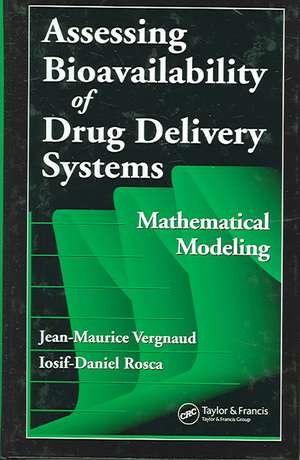Assessing Bioavailablility of Drug Delivery Systems: Mathematical Modeling
Autor Jean-Maurice Vergnaud, Iosif-Daniel Roscaen Limba Engleză Hardback – 26 mai 2005
The author has considerable experience in investigating mathematical fundamentals that are related to pharmaco- and toxicokinetics, modified-release drug products, physiologic pharmacokinetics and statistical treatment in clinical situations. The mathematical models he has developed are particularly powerful because they account for such major parameters as the kinetics of drug release controlled by diffusion or by erosion, and the kinetics of absorption into and elimination out of the plasma. They are also able to solve the problem of determining the drug level in plasma as a result of patient non-compliance, incorrect dosage, and incorrect frequency and to determine the best dosage forms necessary for therapy.
Using master curves, the book highlights the inter-variability of the patients often expressed by different responses towards a drug. Thus, after evaluating a patient's pharmacokinetic parameters, the dose can be adapted to the patient, with the expectation of decreasing the side effects for each patient. Using dimensionless numbers in repeated doses, either for the time or for the plasma drug concentration, makes the master curves useful for every drug, providing that its pharmacokinetics was linear. These master curves address clear information either to the patients or to the therapists in a didactic and easy way. The patients can see from first look the effects of non-compliance and therapists can see the dramatic effects of inter-variability of patients towards a drug.
Drug discovery and dosage forms have become an increasingly time-consuming and expensive process. The development of a single drug can leave behind more than 10 to 15 years of work. Discussing time and cost-effective methods as alternatives to conventional in vivo methods, the book helps you analyze and integrate in vitro/in vivo correlations and apply them to patient care and drug consultation situations.
Preț: 1182.39 lei
Preț vechi: 1668.41 lei
-29% Nou
Puncte Express: 1774
Preț estimativ în valută:
226.32€ • 245.92$ • 190.23£
226.32€ • 245.92$ • 190.23£
Comandă specială
Livrare economică 31 martie-14 aprilie
Doresc să fiu notificat când acest titlu va fi disponibil:
Se trimite...
Preluare comenzi: 021 569.72.76
Specificații
ISBN-13: 9780849330445
ISBN-10: 0849330440
Pagini: 244
Ilustrații: 126 b/w images, 17 tables, 126 halftones and 184 equations
Dimensiuni: 156 x 234 x 17 mm
Greutate: 0.49 kg
Ediția:1
Editura: CRC Press
Colecția CRC Press
Locul publicării:Boca Raton, United States
ISBN-10: 0849330440
Pagini: 244
Ilustrații: 126 b/w images, 17 tables, 126 halftones and 184 equations
Dimensiuni: 156 x 234 x 17 mm
Greutate: 0.49 kg
Ediția:1
Editura: CRC Press
Colecția CRC Press
Locul publicării:Boca Raton, United States
Public țintă
ProfessionalCuprins
Definitions. Intravenous Administration. Oral Dosage Forms With Immediate Release. Kinetics of Drug Release From Oral Sustained Dosage Forms. Bibliography on In Vitro/In Vivo Correlations. Plasma Drug Level With Diffusion-Controlled Dosage Forms. Plasma Drug Level With Erosion-Controlled Dosage Forms. Effect of Non-Compliance on the Plasma Drug Level. Drug Transfer in Various Tissues. Process of Transdermal Drug Transfer.
Recenzii
"…it adds new perspectives on topics…[and] gives an overview of the theoretical and experimental work of its senior author."
-European Journal of Pharmaceutics and Biopharmaceutics
-European Journal of Pharmaceutics and Biopharmaceutics
Notă biografică
Jean-Maurice Vergnaud, Iosif-Daniel Rosca
Descriere
This book introduces mathematical modeling methods for calculating the profiles of plasma levels obtained with controlled release dosage forms and provides examples and case studies to illustrate the techniques employed. The mathematical models developed by the author are particularly powerful because they account for such major parameters as the kinetics of drug release controlled by diffusion or by erosion, and the kinetics of absorption into and elimination out of the plasma. They are also able to solve the problem of determining the drug level in plasma as a result of patient non-compliance, incorrect dosage, and incorrect frequency, and to determine the best dosage forms necessary for therapy.
